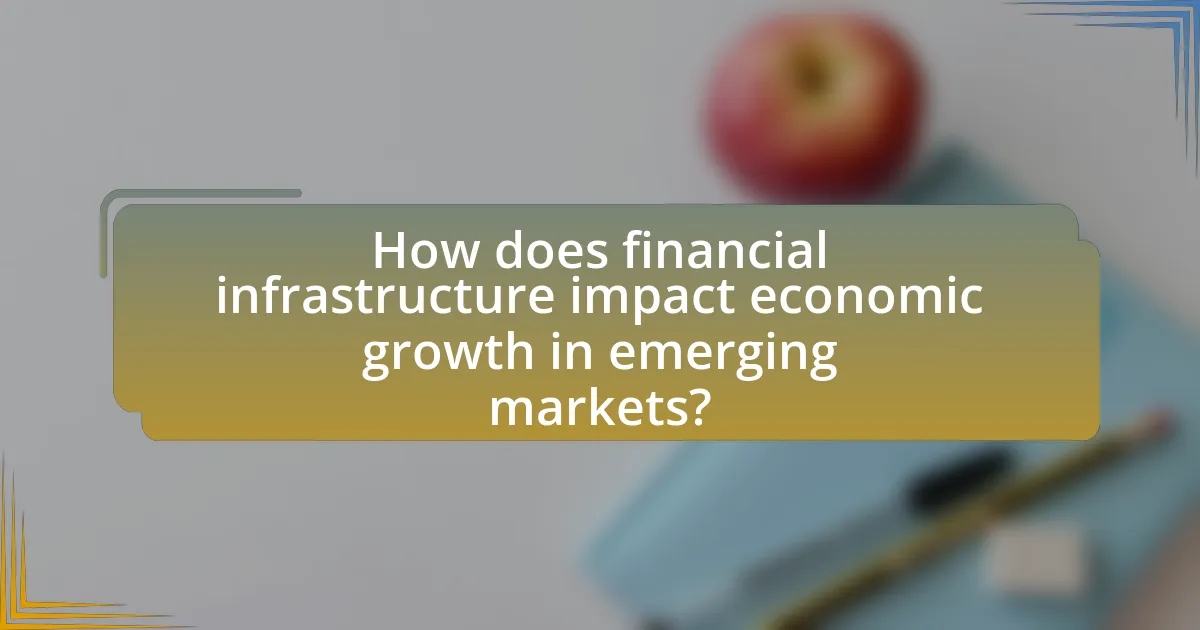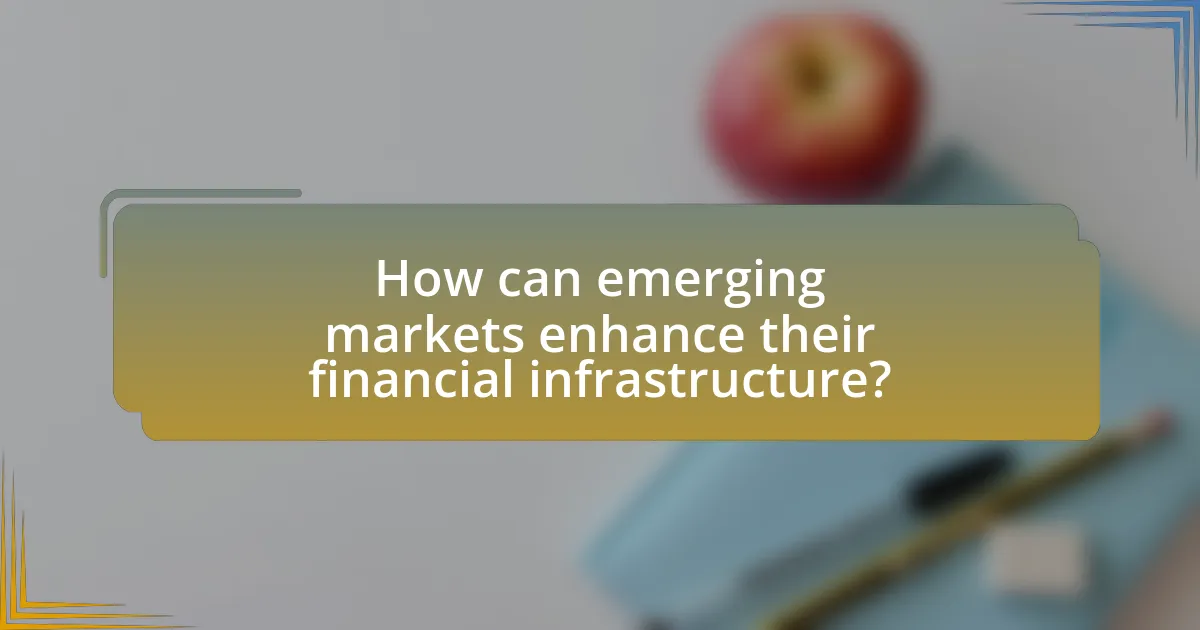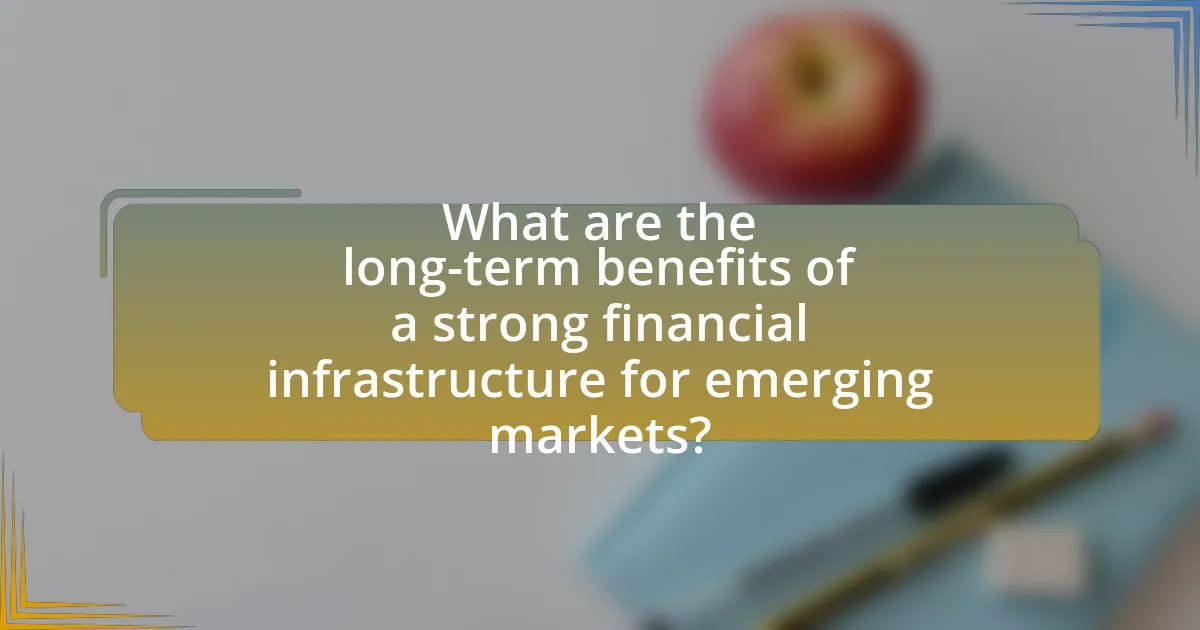Financial infrastructure plays a critical role in supporting economic growth in emerging markets by enhancing access to capital, improving transaction efficiency, and fostering financial stability. Key components of this infrastructure include banking systems, payment networks, regulatory frameworks, and capital markets, all of which facilitate investment and innovation. The article examines how robust financial systems contribute to higher GDP growth rates, promote entrepreneurship, and attract foreign direct investment, while also addressing the challenges emerging markets face in developing these infrastructures. Additionally, it highlights the importance of technology, regulatory reforms, and financial literacy in strengthening financial systems and ensuring sustainable economic development.

How does financial infrastructure impact economic growth in emerging markets?
Financial infrastructure significantly impacts economic growth in emerging markets by facilitating access to capital, improving transaction efficiency, and enhancing financial stability. A robust financial infrastructure, which includes banking systems, payment networks, and regulatory frameworks, enables businesses to secure funding, thereby fostering investment and innovation. For instance, according to the World Bank, countries with well-developed financial systems experience higher rates of GDP growth, as they can mobilize savings and allocate resources more effectively. Additionally, improved financial infrastructure reduces transaction costs and risks, encouraging both domestic and foreign investments, which are crucial for economic expansion.
What are the key components of financial infrastructure?
The key components of financial infrastructure include payment systems, regulatory frameworks, financial institutions, and market infrastructure. Payment systems facilitate the transfer of funds between parties, ensuring efficient transactions. Regulatory frameworks establish the rules and guidelines that govern financial activities, promoting stability and trust. Financial institutions, such as banks and credit unions, provide essential services like lending and savings. Market infrastructure encompasses the platforms and mechanisms that enable trading and investment, such as stock exchanges and clearinghouses. These components collectively support economic growth by enhancing access to finance, improving transaction efficiency, and fostering a stable financial environment.
How do banking systems contribute to financial infrastructure?
Banking systems contribute to financial infrastructure by providing essential services such as payment processing, credit allocation, and risk management. These services facilitate transactions, enhance liquidity, and promote investment, which are critical for economic growth. For instance, according to the World Bank, countries with well-developed banking systems experience higher levels of investment and economic stability, as they enable efficient capital allocation and reduce transaction costs. Furthermore, banking systems support financial inclusion by offering access to financial services for individuals and businesses, thereby fostering entrepreneurship and innovation in emerging markets.
What role do capital markets play in financial infrastructure?
Capital markets are essential components of financial infrastructure, facilitating the allocation of resources and enabling economic growth. They provide a platform for raising capital, allowing businesses and governments to access funds for investment and development. For instance, in emerging markets, capital markets can mobilize savings and channel them into productive investments, which is crucial for infrastructure development and job creation. According to the World Bank, well-functioning capital markets can enhance financial stability and promote economic resilience, thereby supporting sustainable growth in these regions.
How does payment systems development affect economic activities?
Payment systems development significantly enhances economic activities by facilitating faster and more secure transactions. Improved payment systems reduce transaction costs and increase efficiency, enabling businesses to operate more effectively and consumers to engage in commerce with greater ease. For instance, the introduction of mobile payment platforms in emerging markets has led to a surge in e-commerce, with a report from the World Bank indicating that digital payment adoption can increase GDP by up to 3% in developing economies. This growth is driven by increased access to financial services, which empowers individuals and small businesses, ultimately stimulating economic growth and fostering innovation.
Why is financial infrastructure crucial for emerging markets?
Financial infrastructure is crucial for emerging markets because it facilitates access to capital, enhances financial stability, and promotes economic growth. In these markets, robust financial systems enable businesses to secure funding, which is essential for investment and expansion. For instance, according to the World Bank, countries with developed financial infrastructure experience higher rates of economic growth, as they can mobilize savings and allocate resources more efficiently. Furthermore, effective financial infrastructure reduces transaction costs and risks, fostering an environment conducive to entrepreneurship and innovation. This is evidenced by the fact that nations with improved banking systems and payment networks see increased foreign direct investment, which further stimulates economic development.
How does it facilitate access to capital for businesses?
Financial infrastructure facilitates access to capital for businesses by providing essential services such as banking, credit systems, and investment platforms. These services enable businesses to secure loans, attract investors, and manage financial transactions efficiently. For instance, according to the World Bank, countries with robust financial infrastructure experience a 30% increase in access to credit for small and medium enterprises, which are crucial for economic growth in emerging markets. This access allows businesses to invest in expansion, innovation, and job creation, thereby driving overall economic development.
What is the relationship between financial infrastructure and investment levels?
Financial infrastructure significantly influences investment levels by providing the necessary frameworks for efficient capital allocation and risk management. A robust financial infrastructure, which includes banking systems, payment networks, and regulatory frameworks, facilitates access to financing, thereby encouraging both domestic and foreign investments. For instance, countries with well-developed financial markets, such as Singapore, attract higher levels of foreign direct investment due to their reliable financial systems and investor protections. Conversely, nations with weak financial infrastructure often experience lower investment levels, as seen in many emerging markets where limited access to credit and inadequate financial services hinder economic growth.
How does financial infrastructure support entrepreneurship?
Financial infrastructure supports entrepreneurship by providing essential access to capital, financial services, and risk management tools. This infrastructure includes banks, credit unions, venture capital firms, and microfinance institutions that facilitate funding for startups and small businesses. For instance, according to the World Bank, countries with robust financial systems see a higher rate of new business creation, as entrepreneurs can secure loans and investments more easily. Additionally, financial infrastructure enables entrepreneurs to manage risks through insurance products and hedging services, which are crucial for sustaining business operations in volatile markets. Thus, effective financial infrastructure is a key driver of entrepreneurial activity and economic growth in emerging markets.
What challenges do emerging markets face in developing financial infrastructure?
Emerging markets face significant challenges in developing financial infrastructure, primarily due to limited access to capital, regulatory hurdles, and inadequate technological frameworks. Limited access to capital restricts investment in essential financial systems, as many emerging economies struggle to attract foreign direct investment. Regulatory hurdles often stem from inconsistent policies and lack of transparency, which can deter both domestic and international investors. Additionally, inadequate technological frameworks hinder the implementation of modern financial services, as many regions lack the necessary digital infrastructure to support innovations like mobile banking and fintech solutions. According to the World Bank, over 1.7 billion adults remain unbanked globally, with a significant portion residing in emerging markets, highlighting the urgent need for improved financial infrastructure to foster economic growth.
What are the regulatory hurdles in establishing financial systems?
Regulatory hurdles in establishing financial systems include compliance with legal frameworks, obtaining necessary licenses, and adhering to anti-money laundering (AML) and know your customer (KYC) regulations. These requirements can delay the launch of financial services and increase operational costs. For instance, the World Bank’s “Doing Business 2020” report highlights that in many emerging markets, the time to obtain a business license can exceed 30 days, complicating the establishment of new financial institutions. Additionally, regulatory bodies often impose stringent capital requirements, which can limit the ability of startups to enter the market. These factors collectively create a challenging environment for the development of robust financial systems in emerging economies.
How does political instability affect financial infrastructure development?
Political instability significantly hinders financial infrastructure development by creating an unpredictable environment that discourages investment and innovation. When a country experiences political turmoil, such as frequent changes in government, civil unrest, or policy uncertainty, investors often perceive higher risks, leading to reduced capital inflows. For instance, according to the World Bank, countries with high political risk see a decline in foreign direct investment, which is crucial for developing robust financial systems. Additionally, political instability can disrupt existing financial institutions, leading to inefficiencies and a lack of trust among consumers and businesses. This disruption ultimately stifles economic growth, as evidenced by the correlation between political stability and the development of financial markets in emerging economies, where stable governance has been linked to improved access to financial services and infrastructure.

How can emerging markets enhance their financial infrastructure?
Emerging markets can enhance their financial infrastructure by investing in technology, regulatory frameworks, and financial literacy programs. Investment in technology, such as digital payment systems and blockchain, can streamline transactions and reduce costs, as evidenced by the rapid adoption of mobile banking in countries like Kenya, which has significantly increased financial inclusion. Strengthening regulatory frameworks ensures stability and builds investor confidence; for instance, the implementation of Basel III standards has improved risk management in various emerging economies. Additionally, promoting financial literacy equips citizens with the knowledge to engage with financial services effectively, as seen in initiatives across Southeast Asia that have led to increased savings rates and investment in local economies.
What strategies can be implemented to improve financial systems?
To improve financial systems, implementing digital financial services is essential. Digital platforms enhance accessibility, allowing individuals and businesses in emerging markets to engage with financial services more efficiently. For instance, according to the World Bank, mobile banking has increased financial inclusion, with over 1.2 billion people gaining access to financial services through mobile technology since 2011. Additionally, strengthening regulatory frameworks ensures consumer protection and fosters trust in financial institutions, which is crucial for sustainable economic growth. The International Monetary Fund emphasizes that robust regulations can mitigate risks and enhance the stability of financial systems, further supporting economic development in emerging markets.
How can technology be leveraged to strengthen financial infrastructure?
Technology can be leveraged to strengthen financial infrastructure by enhancing efficiency, accessibility, and security in financial transactions. For instance, blockchain technology provides a decentralized ledger that increases transparency and reduces fraud, which is crucial for building trust in financial systems. Additionally, mobile banking applications expand access to financial services for unbanked populations, facilitating economic participation and growth. According to a report by the World Bank, digital financial services can increase financial inclusion by up to 20%, significantly impacting economic development in emerging markets. Furthermore, artificial intelligence can optimize risk assessment and fraud detection, improving the overall stability of financial institutions.
What role do international partnerships play in infrastructure development?
International partnerships are crucial in infrastructure development as they facilitate the sharing of resources, expertise, and technology. These collaborations enable countries, especially in emerging markets, to access funding and innovative solutions that may not be available domestically. For instance, the World Bank and regional development banks often partner with local governments to finance large-scale infrastructure projects, which can lead to improved transportation networks and energy systems. Such partnerships have been shown to enhance project efficiency and sustainability, as evidenced by the successful implementation of the African Union’s Programme for Infrastructure Development in Africa, which aims to boost regional connectivity and economic growth.
What best practices can emerging markets adopt from developed economies?
Emerging markets can adopt several best practices from developed economies, particularly in enhancing financial infrastructure to support economic growth. One key practice is the implementation of robust regulatory frameworks that ensure financial stability and consumer protection, as seen in countries like the United States and Germany, which have established comprehensive banking regulations to mitigate risks. Additionally, emerging markets can benefit from adopting advanced technology in financial services, such as mobile banking and digital payment systems, which have been successfully utilized in developed economies to increase financial inclusion and efficiency. For instance, the widespread use of mobile payment platforms in Sweden has significantly improved transaction speed and accessibility. Furthermore, fostering public-private partnerships can enhance infrastructure development, as demonstrated by the successful collaboration between government and private sectors in the UK to improve transportation and utilities, ultimately driving economic growth. These practices, when tailored to local contexts, can significantly bolster the financial infrastructure of emerging markets, leading to sustainable economic development.
How can lessons from successful financial systems be applied?
Lessons from successful financial systems can be applied by adopting best practices in regulatory frameworks, technology integration, and financial inclusion strategies. For instance, countries like Singapore and Germany have demonstrated that robust regulatory environments foster trust and stability, which can be emulated by emerging markets to enhance investor confidence. Additionally, the use of technology, such as mobile banking in Kenya, has shown that innovative financial solutions can increase access to financial services, thereby promoting economic participation. Furthermore, successful financial systems prioritize financial literacy programs, which empower individuals to make informed financial decisions, a strategy that can significantly improve economic outcomes in emerging markets. These applications are supported by evidence that countries with strong financial infrastructures experience higher rates of economic growth and stability.
What are the key indicators of a robust financial infrastructure?
Key indicators of a robust financial infrastructure include a well-developed payment system, strong regulatory frameworks, and access to financial services. A well-developed payment system facilitates efficient transactions, which is essential for economic activities; for instance, countries with advanced payment systems, like Sweden, have seen increased economic efficiency and lower transaction costs. Strong regulatory frameworks ensure stability and protect consumers, as evidenced by the Basel III standards that enhance bank resilience globally. Access to financial services, including banking and credit, is crucial for economic participation; according to the World Bank, countries with higher financial inclusion rates experience faster economic growth.

What are the long-term benefits of a strong financial infrastructure for emerging markets?
A strong financial infrastructure provides long-term benefits for emerging markets by enhancing economic stability, facilitating investment, and promoting financial inclusion. Economic stability is achieved through improved risk management and regulatory frameworks, which reduce volatility and foster investor confidence. For instance, countries with robust financial systems, such as South Korea and Singapore, have demonstrated resilience during global financial crises, showcasing the importance of a solid financial foundation.
Additionally, a well-developed financial infrastructure attracts both domestic and foreign investments, as it offers efficient capital allocation and access to credit. According to the World Bank, countries with advanced financial systems experience higher levels of foreign direct investment, which is crucial for economic growth.
Moreover, strong financial infrastructure promotes financial inclusion by providing access to banking services for underserved populations. This inclusion leads to increased savings, investment in education, and entrepreneurship, ultimately contributing to sustainable economic development. The Global Findex Database indicates that financial inclusion can significantly boost GDP growth in emerging economies.
In summary, the long-term benefits of a strong financial infrastructure for emerging markets include enhanced economic stability, increased investment, and improved financial inclusion, all of which are critical for sustained economic growth.
How does improved financial infrastructure lead to sustainable economic growth?
Improved financial infrastructure leads to sustainable economic growth by enhancing access to financial services, which facilitates investment and consumption. When financial systems are robust, they provide individuals and businesses with the necessary tools to save, borrow, and invest efficiently. For instance, according to the World Bank, countries with well-developed financial systems experience higher rates of economic growth, as they can mobilize savings and allocate resources more effectively. This mobilization of capital supports entrepreneurship and innovation, driving productivity and job creation, which are essential for long-term economic sustainability.
What impact does financial inclusion have on poverty reduction?
Financial inclusion significantly reduces poverty by providing individuals and businesses access to essential financial services such as savings accounts, credit, and insurance. Access to these services enables low-income populations to invest in education, healthcare, and entrepreneurial activities, which are critical for improving their economic status. For instance, a World Bank report indicates that a 10% increase in financial inclusion can lead to a 0.5% reduction in poverty rates. Furthermore, financial inclusion fosters economic resilience by allowing households to manage risks and cope with financial shocks, ultimately contributing to sustainable poverty alleviation.
How does financial infrastructure contribute to stability in economic crises?
Financial infrastructure contributes to stability in economic crises by providing a robust framework for financial transactions, risk management, and liquidity support. This framework includes institutions such as banks, payment systems, and regulatory bodies that facilitate efficient capital flow and maintain trust in the financial system. For instance, during the 2008 financial crisis, countries with strong financial infrastructures, like the United States, were able to implement measures such as the Troubled Asset Relief Program (TARP) to stabilize banks and restore confidence, which mitigated the crisis’s impact. Additionally, effective financial infrastructure enables timely access to credit and liquidity, which is crucial for businesses and consumers during downturns, thereby supporting economic resilience.
What practical steps can policymakers take to foster financial infrastructure development?
Policymakers can foster financial infrastructure development by implementing regulatory frameworks that encourage investment in financial technologies and institutions. Establishing clear regulations can attract private sector investment, as seen in countries like Kenya, where the regulatory environment for mobile banking has led to significant growth in financial services. Additionally, policymakers should invest in public-private partnerships to enhance infrastructure, as demonstrated by the collaboration between the government and private firms in India to expand digital payment systems. Furthermore, providing incentives for innovation, such as tax breaks for fintech startups, can stimulate the development of new financial solutions, which has been effective in regions like Southeast Asia. Lastly, enhancing financial literacy programs can empower consumers to engage with financial services, thereby increasing demand and supporting infrastructure growth.
How can governments incentivize private sector investment in financial systems?
Governments can incentivize private sector investment in financial systems by implementing tax incentives, regulatory reforms, and public-private partnerships. Tax incentives, such as reduced corporate tax rates or tax credits for investments in financial technology, encourage private firms to allocate resources toward developing financial infrastructure. Regulatory reforms that streamline compliance processes and reduce barriers to entry can attract more private investment by creating a more favorable business environment. Public-private partnerships, where governments collaborate with private entities to fund and develop financial systems, can leverage private capital while sharing risks. For instance, the World Bank has reported that countries with supportive regulatory frameworks and tax incentives see higher levels of private investment in financial sectors, demonstrating the effectiveness of these strategies.
What role does education play in enhancing financial literacy and infrastructure?
Education plays a crucial role in enhancing financial literacy and infrastructure by equipping individuals with the knowledge and skills necessary to make informed financial decisions. Financial education programs improve understanding of budgeting, saving, investing, and credit management, which are essential for effective participation in the financial system. According to a study by the Organisation for Economic Co-operation and Development (OECD), countries with higher levels of financial literacy tend to have more robust financial infrastructures, as informed citizens are better able to utilize financial services and products. This correlation indicates that education not only empowers individuals but also strengthens the overall economic framework, facilitating growth in emerging markets.


